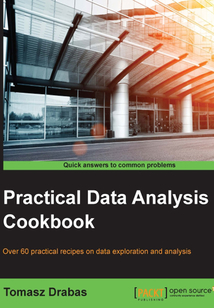舉報 

會員
目錄(113章)
倒序
- coverpage
- Practical Data Analysis Cookbook
- Credits
- About the Author
- Acknowledgments
- About the Reviewers
- www.PacktPub.com
- Support files eBooks discount offers and more
- Preface
- What this book covers
- What you need for this book
- Who this book is for
- Sections
- Conventions
- Reader feedback
- Customer support
- Chapter 1. Preparing the Data
- Introduction
- Reading and writing CSV/TSV files with Python
- Reading and writing JSON files with Python
- Reading and writing Excel files with Python
- Reading and writing XML files with Python
- Retrieving HTML pages with pandas
- Storing and retrieving from a relational database
- Storing and retrieving from MongoDB
- Opening and transforming data with OpenRefine
- Exploring the data with Open Refine
- Removing duplicates
- Using regular expressions and GREL to clean up data
- Imputing missing observations
- Normalizing and standardizing the features
- Binning the observations
- Encoding categorical variables
- Chapter 2. Exploring the Data
- Introduction
- Producing descriptive statistics
- Exploring correlations between features
- Visualizing the interactions between features
- Producing histograms
- Creating multivariate charts
- Sampling the data
- Splitting the dataset into training cross-validation and testing
- Chapter 3. Classification Techniques
- Introduction
- Testing and comparing the models
- Classifying with Na?ve Bayes
- Using logistic regression as a universal classifier
- Utilizing Support Vector Machines as a classification engine
- Classifying calls with decision trees
- Predicting subscribers with random tree forests
- Employing neural networks to classify calls
- Chapter 4. Clustering Techniques
- Introduction
- Assessing the performance of a clustering method
- Clustering data with k-means algorithm
- Finding an optimal number of clusters for k-means
- Discovering clusters with mean shift clustering model
- Building fuzzy clustering model with c-means
- Using hierarchical model to cluster your data
- Finding groups of potential subscribers with DBSCAN and BIRCH algorithms
- Chapter 5. Reducing Dimensions
- Introduction
- Creating three-dimensional scatter plots to present principal components
- Reducing the dimensions using the kernel version of PCA
- Using Principal Component Analysis to find things that matter
- Finding the principal components in your data using randomized PCA
- Extracting the useful dimensions using Linear Discriminant Analysis
- Using various dimension reduction techniques to classify calls using the k-Nearest Neighbors classification model
- Chapter 6. Regression Methods
- Introduction
- Identifying and tackling multicollinearity
- Building Linear Regression model
- Using OLS to forecast how much electricity can be produced
- Estimating the output of an electric plant using CART
- Employing the kNN model in a regression problem
- Applying the Random Forest model to a regression analysis
- Gauging the amount of electricity a plant can produce using SVMs
- Training a Neural Network to predict the output of a power plant
- Chapter 7. Time Series Techniques
- Introduction
- Handling date objects in Python
- Understanding time series data
- Smoothing and transforming the observations
- Filtering the time series data
- Removing trend and seasonality
- Forecasting the future with ARMA and ARIMA models
- Chapter 8. Graphs
- Introduction
- Handling graph objects in Python with NetworkX
- Using Gephi to visualize graphs
- Identifying people whose credit card details were stolen
- Identifying those responsible for stealing the credit cards
- Chapter 9. Natural Language Processing
- Introduction
- Reading raw text from the Web
- Tokenizing and normalizing text
- Identifying parts of speech handling n-grams and recognizing named entities
- Identifying the topic of an article
- Identifying the sentence structure
- Classifying movies based on their reviews
- Chapter 10. Discrete Choice Models
- Introduction
- Preparing a dataset to estimate discrete choice models
- Estimating the well-known Multinomial Logit model
- Testing for violations of the Independence from Irrelevant Alternatives
- Handling IIA violations with the Nested Logit model
- Managing sophisticated substitution patterns with the Mixed Logit model
- Chapter 11. Simulations
- Introduction
- Using SimPy to simulate the refueling process of a gas station
- Simulating out-of-energy occurrences for an electric car
- Determining if a population of sheep is in danger of extinction due to a wolf pack
- Index 更新時間:2021-07-16 11:14:22
推薦閱讀
- Flask Web全棧開發實戰
- C++ Primer習題集(第5版)
- Delphi程序設計基礎:教程、實驗、習題
- PHP 編程從入門到實踐
- Highcharts Cookbook
- Java系統化項目開發教程
- Visual FoxPro程序設計習題集及實驗指導(第四版)
- 常用工具軟件立體化教程(微課版)
- ArcGIS for Desktop Cookbook
- Microsoft 365 Certified Fundamentals MS-900 Exam Guide
- Mastering Python Design Patterns
- jQuery for Designers Beginner's Guide Second Edition
- Instant Automapper
- Android技術內幕(系統卷)
- LabVIEW數據采集(第2版)
- 3D Printing Designs:Design an SD Card Holder
- Appcelerator Titanium Smartphone App Development Cookbook
- Access 2016數據庫應用與開發:實戰從入門到精通(視頻教學版)
- 米思齊實戰手冊:Arduino圖形化編程指南
- Boost.Asio C++ Network Programming Cookbook
- 計算機應用基礎
- Objective-C入門教程
- Python機器學習
- Oracle Application Integration Architecture(AIA) Foundation Pack 11gR1:Essentials
- Heroku Cookbook
- Arduino Essentials
- 零基礎學Python編程實戰
- Blueprints Visual Scripting for Unreal Engine
- 可編程控制器原理及應用
- 輕松學PHP

